Appalachian Hardwood
Species Guide
Consistently awarded the highest grade and quality rating, Appalachian
Hardwoods are the lumber of choice for those who choose the best. No
matter your needs, Appalachian Hardwoods make a difference in the
stability and quality of your products. Click on each species below:

The Oaks
The oaks represent the largest and
most important group of hardwoods in the Appalachian region. They grow
throughout the eastern part of the country and a few species are found
in scattered hardwood stands on the West Coast. In all, there are 80
species of oak native to the U.S. The oaks are divided into two
groups: the red oaks and white oaks. An important feature enhancing
the quality of Appalachian oak is that fewer sub-species reach the
commercial market. This is of particular advantage to furniture
manufacturers, architectural woodworkers and flooring manufacturers,
in that they are assured of uniform quality.
APPALACHIAN WHITE OAK. Quercus Alba
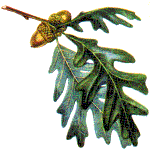 Leaves: Simple, pinnately
lobed, tips smooth, 5"-9" long, 2"-4" wide, occurring alternately on
the stem.
Leaves: Simple, pinnately
lobed, tips smooth, 5"-9" long, 2"-4" wide, occurring alternately on
the stem.
Fruit: Acorn 1/2"-1" long, oval shaped, fez-like cap.
Bark: Light gray, flaky
Uses: Furniture, subflooring, flooring, interior trim, cabinets,
ships, truck bodies, tight cooperage,
farm implements, natural finish, paneling, truck & trailer flooring,
and pallets.
APPALACHIAN RED OAK. Quercus
Borealis (rubra)
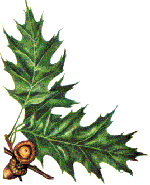 Leaves: Simple, pinnately lobed
tips have bristle protruding; 5"-8" long; 4"-5" wide, occurring
Leaves: Simple, pinnately lobed
tips have bristle protruding; 5"-8" long; 4"-5" wide, occurring
alternately on the stem.
Fruit: Acorn 1/2"-1" long, oval-shaped; cap, ivy-league like.
Bark: Dark brown to black, deeply fissured in vertical lines,
occasional cross breaks.
Uses: Same as white oak except not ships, tight cooperage.

The Maples
The maples represent about 10 percent of the standing timber and
volume of lumber production. There are many species of maple
throughout the world but in the Appalachian area only two are
important commercially; the sugar maple (Acer saccharum) and the red
maple (Acer rubrum). The maples can be divided into the hard and soft
maples. In the northern part of its range, maple syrup and maple sugar
are made from the sap of the hard maple.
APPALACHIAN HARD MAPLE (SUGAR MAPLE)
-- Acer Saccharum
 Sugar maple grows throughout the
eastern United States except for the South Atlantic and Gulf Coastal
Plains.
Sugar maple grows throughout the
eastern United States except for the South Atlantic and Gulf Coastal
Plains.
Leaves: Simple, palmately lobed usually 5-lobed, 3"-5" in diameter,
occurring opposite on the stem.
Fruit: Sumara (winged seed) borne in pairs about 1"- 1 1/2" long
maturing in the fall.
Bark: Dark gray in color, deeply furrowed with long irregular thick
plates.
Wood: Brown to light tan in heartwood; white in sapwood. Hard and
heavy, weighing about 3.6 lbs. per board foot at eight percent
content. Wood is diffuse porous, with indistinct grain pattern,
although springwood is readily evident.
Uses: Paneling and interior trim flooring (ballrooms, skating rinks,
bowling alleys, textile plants and other industrial floors) furniture,
cabinet, bowling pins, and toys.
APPALACHIAN SOFT MAPLE (RED MAPLE)
-- Acer Rubrum
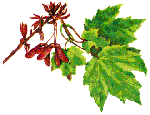 Red maple grows throughout the
eastern United States from Maine to Florida and westward to the
Mississippi Valley and Great Lakes.
Red maple grows throughout the
eastern United States from Maine to Florida and westward to the
Mississippi Valley and Great Lakes.
Leaves: Simple, palmately lobed, usually three-lobed; sometimes five,
2"-6" in diameter occurring opposite on the stem
Fruit: Sumara (winged seed) borne in pairs about 3/4" long, matures
in spring.
Bark: Dark gray in color, thin scaly plates separated by shallow
fissures.
Wood: Gray in color in heartwood; white in sapwood. Softer and
lighter in weight than hard maple, weighing about 3.2 lbs. per bd. ft.
at 8 percent moisture.
Uses: Boxes and crates, flooring, cabinets, furniture, toys.

APPALACHIAN YELLOW POPLAR
OR TULIP
TREE - Liriodendron tulipfera
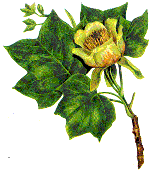 Yellow poplar represents a
significant percentage of the growth and production in the region. It
is a prolific seeder and often occurs in pure stands. It grows
throughout the East from southern New England to the Gulf of Mexico
and westward to the Mississippi River and to an elevation of about
3,500 feet in the mountains. It makes its best growth both from a
quality and size standpoint in coves.
Yellow poplar represents a
significant percentage of the growth and production in the region. It
is a prolific seeder and often occurs in pure stands. It grows
throughout the East from southern New England to the Gulf of Mexico
and westward to the Mississippi River and to an elevation of about
3,500 feet in the mountains. It makes its best growth both from a
quality and size standpoint in coves.
Leaves: Simple, palmately, 3-lobed with the upper lobe more or less
flat. 4"-6" in diameter occurring alternately on the stem. The bud
is distinctive in that it looks somewhat like a duck bill.
Fruit: 2"-3" long and about 1" in diameter composed of a mass of
seeds in the form of Sumaras (winged seeds). This is formed from the
large tulip-like flower from which the tree gets its name.
Bark: Brown to dark gray, deeply diamond shaped fissures, ashy-gray
color at base of fissures.
Wood: The wood is diffuse, porous, light weight, weighing about
2.5-3.0 lbs. per bd. ft. at eight percent moisture content. The
heartwood is greenish yellow in color while the sapwood is white. It
is easily worked, relatively stable wood, and takes and holds paints
and stains better than any other.
Uses: Weatherboard and siding; painted and stained interior or trim
and paneling; furniture and furniture parts; picture frames; window
frames; cabinets; pallets; plywood; and MDF board.

APPALACHIAN BEECH -- Fagus
gradifolia
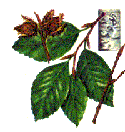 Beech grows throughout the eastern
United States except for southern Florida. In the Appalachian area it
often grows in pure stands on the lower north and east slopes of the
mountains and its distinctive gray twig color makes a "beech line"
around the mountain.
Beech grows throughout the eastern
United States except for southern Florida. In the Appalachian area it
often grows in pure stands on the lower north and east slopes of the
mountains and its distinctive gray twig color makes a "beech line"
around the mountain.
Leaves: Simple, slim oval, 2 1/2" - 6" long and 1 1/4" - 2" wide
occurring alternately on the stem. The bud is also distinctive in that
it looks like a miniature cigar.
Fruit: An edible nut 1/2" in triangular cross section, paired, or in
threes, in a spiny husk.
Bark: The bark is very distinctive being light gray in color and very
smooth and thin. People like to carve their initials in it.
Wood: The wood is golden brown in the heartwood; almost white in
sapwood. It is strong, hard and heavy, weighing about 3.8 lbs. per
bd. ft. It is diffuse, porous, and has inter-locking grain which
requires care in drying.
Uses: Furniture, paneling, flooring, toys, trailer floors, novelties.

APPALACHIAN WHITE ASH - Fraxinus
Americana
 Ash is of the olive tree family. It
grows throughout the eastern part of the United States. There are
about 20 species of Ash found throughout the world but only five are
important in this country. In the Appalachian area only the White Ash
is of commercial importance. It represents about 3-5 percent of the
total volume of timber and lumber production. It grows throughout the
Appalachian area, except at the higher elevations.
Ash is of the olive tree family. It
grows throughout the eastern part of the United States. There are
about 20 species of Ash found throughout the world but only five are
important in this country. In the Appalachian area only the White Ash
is of commercial importance. It represents about 3-5 percent of the
total volume of timber and lumber production. It grows throughout the
Appalachian area, except at the higher elevations.
Leaves: Pinnately compound, 8"-12" long with 7-9 leaflets (usually 7)
3"-5" long, 1 1/2" - 3" wide, leaves occurring opposite on the stem.
Fruit: Sumara (winged seed) 1"-2" long, 1/4" wide.
Bark: Ashy gray or light brown in color, diamond shaped furrows, bark
fairly thick.
Wood: Ring porous, is fairly hard and heavy and very tough. The
heartwood is a light brown or tan color; while the sapwood is an "off
white." It weighs about 3.5 lbs. per bd. ft. at 8 percent moisture.
Uses: Baseball bats; water skies; furniture, sporting goods, paneling
and cabinets.

APPALACHIAN BASSWOOD
-- Tilia glabra
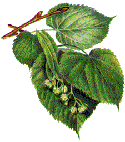 Basswood is also known as
American Linden or Linnwood, or just Linn. It grows throughout the
northeast, ranging from Maine to Minnesota, south to Missouri and
eastward through Kentucky and West Virginia to the coast. It
represents about 8 percent of the volume of timber and lumber
production in the region. It is a prolific sprouter, often found in
clumps with several stems.
Basswood is also known as
American Linden or Linnwood, or just Linn. It grows throughout the
northeast, ranging from Maine to Minnesota, south to Missouri and
eastward through Kentucky and West Virginia to the coast. It
represents about 8 percent of the volume of timber and lumber
production in the region. It is a prolific sprouter, often found in
clumps with several stems.
Leaves: Simple, broadly oval, lop-sides, 5"-6" long, 3"-4" wide,
occurring alternately on the steam.
Fruit: A nut about 1/2" in diameter hanging from a bract in groups.
Has the appearance of a pawnbroker's symbol.
Bark: Brown to dark gray, deep narrow ridges, somewhat scaly on the
surface. The tree gets its name from the inner bark, or bast, used by
the Indians to make ropes.
Wood: Heartwood: light reddish brown; sapwood: white. Very light
and soft, easily worked and very stable. Weighs about 2.2 lbs. per
bd. ft. at 8 percent moisture. Wood is diffuse, porous.
Uses: Boxes and crates; core stock for veneer panels, piano keys,
furniture, interior trim, honey boxes, cabinets and luggage.

APPALACHIAN BLACK WALNUT -- Juglans
Nigra
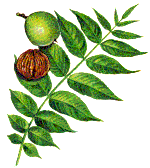 Black walnut is one of the most
valuable timber trees. It grows throughout the eastern United States
except for the Gulf States and the higher elevations in the
mountains. It grows westward into Nebraska, Kansas, Oklahoma and
Texas. In the Appalachian area it represents about 1 percent of the
volume of the stand and lumber production, and is important as a
commodity for export in the form of veneer logs.
Black walnut is one of the most
valuable timber trees. It grows throughout the eastern United States
except for the Gulf States and the higher elevations in the
mountains. It grows westward into Nebraska, Kansas, Oklahoma and
Texas. In the Appalachian area it represents about 1 percent of the
volume of the stand and lumber production, and is important as a
commodity for export in the form of veneer logs.
Leaves: Pinnately compound, 15"-30" long, with 11-17 leaflets, 3"-4"
long and 1 1/2"-2" wide, occurring alternately on the stem.
Fruit: An edible nut 1"-1 1/2" in diameter enclosed in a fleshy husk
about 1/2" thick--often occurs in pairs on the stem.
Bark: Dark brown "walnut" color, thick, deeply furrowed, making
diamond shaped patterns. Pith is distinct in the twigs in that it is
light brown in color and diaphragmed. The color distinguishes the
tree from Butternut, which has a dark brown pith.
Wood: Dark chocolate brown color in heartwood; sapwood, white to very
light tan. The wood is fairly hard and medium in weight, weighing
about 3.2 lbs. per bd. ft. The wood is semi-ring porous which imparts
a distinctive grain pattern. The wood can be placed in a steam vat
and the heartwood and sapwood will become the same dark color.
Uses: Furniture, gunstocks, cabinets, specialty flooring, interior
trim, paneling, veneer, architectural woodwork.

APPALACHIAN BIRCH -- Yellow Birch, Betula Lutea
 Birch is primarily a northern
specie, but enjoys excellent growth in the higher elevations of the
Appalachian region. Its range covers the area from Maine to
Minnesota, southward into northern Illinois and into western North
Carolina and eastern Tennessee, along the upper elevations of the
mountains. It is of minor importance as a timber tree in the
Appalachian area except to those producers in the northern part of the
region. It represents about five percent of the volume of timber and
lumber produced.
Birch is primarily a northern
specie, but enjoys excellent growth in the higher elevations of the
Appalachian region. Its range covers the area from Maine to
Minnesota, southward into northern Illinois and into western North
Carolina and eastern Tennessee, along the upper elevations of the
mountains. It is of minor importance as a timber tree in the
Appalachian area except to those producers in the northern part of the
region. It represents about five percent of the volume of timber and
lumber produced.
Leaves: Simple, slim oval, 3"-4 1/2" long, 1 1/2"-2" wide, occurring
alternately on the stem.
Fruit: Cone is 1"-1 1/2" long, bearing small winged seeds about 1/4"
long.
Bark: Golden gray to bronze color, flaky, with curled, papery strips
at ends.
Wood: Golden brown in heartwood; very light tan or off-white in
sapwood. Hard, strong, heavy, weighing 3.6 lbs. per bd. ft. at 8
percent moisture. Diffuse, porous with indistinct grain pattern.
Uses: Furniture, paneling, interior trim, toys, novelties,
architectural woodwork and cabinets.

APPALACHIAN CHERRY, BLACK CHERRY,
WILD CHERRY -- Prunus serotina
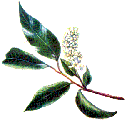 Cherry grows throughout the
eastern United States except for the southern part of Florida, ranging
from the Canadian border to the Gulf, and from the Atlantic Coast to
the Great Plains. It does not grow in abundance in the Appalachian
area, representing about one percent of the volume of timber and
lumber production. Cherry is a highly-prized wood for furniture, and
in its northern range is extensively cut into veneer. The lumber is
cut from the fine trees in the Appalachian area, but the gum spots,
typical of Cherry wood, are often too large for veneer to be made from
trees from this area.
Cherry grows throughout the
eastern United States except for the southern part of Florida, ranging
from the Canadian border to the Gulf, and from the Atlantic Coast to
the Great Plains. It does not grow in abundance in the Appalachian
area, representing about one percent of the volume of timber and
lumber production. Cherry is a highly-prized wood for furniture, and
in its northern range is extensively cut into veneer. The lumber is
cut from the fine trees in the Appalachian area, but the gum spots,
typical of Cherry wood, are often too large for veneer to be made from
trees from this area.
Leaves: Simple, slim oval, 2"-6" long, 1"-1/2" wide, occurring
alternately on the stem.
Fruit: An edible drupe, commonly called a cherry; 1/3"-1/2" in
diameter occurring in groups along a central stem.
Bark: Black, covered with thin small scales turned up at edges,
ridges running up and down and crossways giving a plated effect.
Wood: Wood is diffuse, porous with indistinct grain pattern.
Heartwood is light to dark red in color; sapwood, white. It is of
medium hardness and weighs about 2.2 lbs. per bd. ft. at 8 percent
moisture.
Uses: Furniture, interior trim and paneling, instrument cabinets,
carpenters' levels, veneer.

APPALACHIAN HICKORY: Shagbark - Carya Ovata - Pignut - Carya Glabra
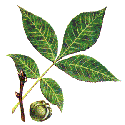 There are 19 species of hickory
native to the United States. Fourteen are "true hickories" while the
remaining five come under the category of "pecan hickories." In the
identification of lumber, however, all hickories are identified as
such by a National Hardwood Lumber Association inspector and no
separation is made. The pecan hickories have a less pronounced grain
pattern and include butternut hickory, pecan (Carya pecan), nutmeg
hickory and water hickory. These are southern species for the most
part and are not of commercial importance in the Appalachian area.
Two species are commercially important in the mountains---the shagbark
and pignut. Their growing characteristics and wood are similar; the
bark being the main distinguishing mark.
There are 19 species of hickory
native to the United States. Fourteen are "true hickories" while the
remaining five come under the category of "pecan hickories." In the
identification of lumber, however, all hickories are identified as
such by a National Hardwood Lumber Association inspector and no
separation is made. The pecan hickories have a less pronounced grain
pattern and include butternut hickory, pecan (Carya pecan), nutmeg
hickory and water hickory. These are southern species for the most
part and are not of commercial importance in the Appalachian area.
Two species are commercially important in the mountains---the shagbark
and pignut. Their growing characteristics and wood are similar; the
bark being the main distinguishing mark.
The shagbark hickory grows throughout the eastern United States except
for the South Atlantic and Gulf Coastal Plains. The pignut covers a
similar area but does not reach so far south.
Hickory has not been cut in the forest of the Appalachian region in
years past, so today it is abundant. Hickory is also known as
"Appalachian Pecan."
Leaves: Pinnately compound, 8"-14" long with 5-9 leaflets, 5"-7" long,
2"-3" wide with the base leaflets much smaller than others. Leaves
occur alternately on stem.
Fruit: An edible nut about 1" in diameter covered by a husk about
1/4" thick.
Bark: On shagbark, the bark occurs in smooth plates which curl at the
ends and break away from the trunk, giving a shaggy appearance. On
the pignut the bark is thin and tight with shallow, vertical fissures,
sometimes slightly scaly.
Wood: Very hard, very heavy, very strong. It weighs about 4.4 lbs.
per bd. ft. at 8 percent moisture. The fine grain and uniform texture
of Appalachian Hickory makes it easier to work than hickory from
outside the mountains. Sometimes there are bird pecks in the wood
which add character and interest to the finished product.
Uses: Furniture, handles, picker sticks, sporting goods (gymnastic
parallel bars, and skis).

Leaves distinguish hardwood trees like
faces identify people. Through these identifying characteristics trees
can be divided into groups. Leaf shapes sometimes vary on the same
tree but do not lose their identity. The first division can be made
with leaves which occur opposite on the stem and those which occur
alternately. Leaves are simple or compound. Leaves are lobed or
oval, and, they are broad oval or slim oval.
Compound Leaves
To be a leaf the stem of the leaf must leave the main branch at a
point where a bud occurs. In compound leaves there is no bud at the
base of the leaflet. Compound leaves are further divided into
palmately and pinnately compound. Palmately compound leaves have the
stems of the leaflet emerging from a central point such as buckeye and
horse chestnut; pinnately compound leaflets occur along a central
stem. Examples are ash, walnut, butternut, locust and hickory.
Simple leaves are those on a single stem having a bud at the base.
Lobed Leaves
Lobed leaves are divided into palmately and pinnately lobed. In the
Palmately lobed, the lobes originate at the central point of the base
of the leaf such as yellow poplar, the maples, gum and sycamore. In
pinnately lobed they occur along the stem such as the oaks.
Oval Leaves
Slim oval are those leaves which are more than twice as long as they
are wide. Trees with slim oval leaves are cherry, beech and birch.
Broad oval are less than twice as long as they are wide. Basswood,
elm and catalpa are broad oval leaves.



